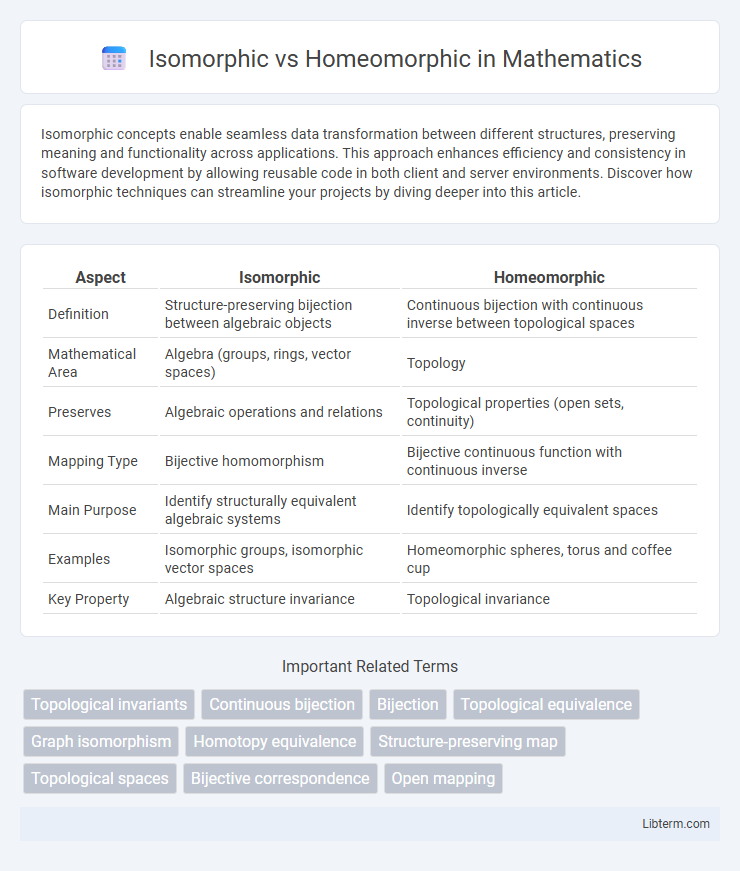Isomorphic concepts enable seamless data transformation between different structures, preserving meaning and functionality across applications. This approach enhances efficiency and consistency in software development by allowing reusable code in both client and server environments. Discover how isomorphic techniques can streamline your projects by diving deeper into this article.
Table of Comparison
| Aspect | Isomorphic | Homeomorphic |
|---|---|---|
| Definition | Structure-preserving bijection between algebraic objects | Continuous bijection with continuous inverse between topological spaces |
| Mathematical Area | Algebra (groups, rings, vector spaces) | Topology |
| Preserves | Algebraic operations and relations | Topological properties (open sets, continuity) |
| Mapping Type | Bijective homomorphism | Bijective continuous function with continuous inverse |
| Main Purpose | Identify structurally equivalent algebraic systems | Identify topologically equivalent spaces |
| Examples | Isomorphic groups, isomorphic vector spaces | Homeomorphic spheres, torus and coffee cup |
| Key Property | Algebraic structure invariance | Topological invariance |
Introduction to Isomorphism and Homeomorphism
Isomorphism and homeomorphism are fundamental concepts in mathematics used to describe structural equivalences between objects. An isomorphism refers to a bijective mapping between algebraic structures, such as groups or rings, that preserves the operations and relations, indicating these structures are essentially the same in algebraic context. Homeomorphism involves a continuous bijection with a continuous inverse between topological spaces, ensuring that the spaces are topologically identical despite possible differences in shape or size.
Defining Isomorphic Structures
Isomorphic structures are entities that share an exact correspondence in form and function, meaning there exists a bijective mapping preserving their operations and relations. In mathematics, especially graph theory and algebra, isomorphism signifies that two objects are structurally identical despite possible differences in labeling or representation. This concept ensures that isomorphic structures exhibit indistinguishable properties and behaviors, facilitating equivalence classification within a specific domain.
Understanding Homeomorphic Spaces
Homeomorphic spaces share a topological equivalence characterized by a continuous, bijective map with a continuous inverse, preserving properties like connectedness and compactness. Unlike isomorphic structures in algebra that require strict structural correspondence, homeomorphism captures the essence of space deformation without tearing or gluing. Understanding homeomorphic spaces is fundamental in topology for classifying spaces based on their intrinsic shape rather than geometric form.
Key Differences Between Isomorphic and Homeomorphic
Isomorphic structures share an exact one-to-one correspondence that preserves operation and relations, making their algebraic properties identical. Homeomorphic spaces possess a continuous, bijective function with a continuous inverse, preserving topological properties but not necessarily algebraic or metric structure. Key differences lie in isomorphisms maintaining algebraic structure while homeomorphisms preserve topological features, reflecting algebraic equivalence versus topological equivalence, respectively.
Mathematical Contexts for Isomorphic vs Homeomorphic
Isomorphic structures, primarily studied in abstract algebra, refer to objects that have a bijective map preserving operations or relations, ensuring they are algebraically identical in form. Homeomorphic objects, central in topology, describe spaces that are continuously deformable into each other via bijective, continuous maps with continuous inverses, preserving topological properties like connectedness and compactness. Understanding the distinction highlights that isomorphisms preserve algebraic structures such as groups or rings, while homeomorphisms preserve the intrinsic geometric or topological properties of spaces.
Real-World Examples of Isomorphic Objects
Isomorphic objects share structural similarities allowing them to be mapped onto each other preserving relational properties, such as two identical computer network topologies where each node corresponds precisely. Examples include chemical compounds like benzene rings with different labels but identical bonding patterns, and social networks where friendship graphs exhibit the same connectivity despite different individuals. These instances illustrate how isomorphism captures equivalence in essential structure despite superficial differences.
Homeomorphism in Topology Explained
Homeomorphism in topology refers to a continuous, bijective function between two topological spaces that has a continuous inverse, preserving the spaces' inherent topological properties. Unlike isomorphisms in algebra, which require structure-preserving maps between algebraic objects, homeomorphisms focus strictly on the preservation of spatial properties like connectedness and compactness. This concept is fundamental in classifying spaces up to topological equivalence, where two spaces are considered essentially the same if they are homeomorphic.
Applications in Mathematics and Science
Isomorphic structures in mathematics preserve relational properties between elements, enabling the transfer of results across algebraic systems such as groups, rings, and vector spaces, which is crucial for simplifying complex problems in abstract algebra and computer science. Homeomorphic mappings maintain topological properties, allowing scientists and mathematicians to classify surfaces and spaces through continuous deformations without tearing or gluing, which is essential in topology and the study of geometric shapes. Applications of isomorphism appear in graph theory for network analysis, while homeomorphism underpins concepts in differential geometry and the qualitative study of dynamical systems.
Common Misconceptions and Clarifications
Isomorphic and homeomorphic are often confused, but isomorphism refers to a structure-preserving bijection between algebraic objects like graphs or groups, while homeomorphism concerns a continuous, bijective map with a continuous inverse between topological spaces. A common misconception is assuming all isomorphic structures are also homeomorphic, ignoring that isomorphism does not imply topological equivalence. Clarifying this distinction aids in understanding that isomorphism captures algebraic similarity, whereas homeomorphism captures topological equivalence regardless of geometric shape.
Conclusion: Choosing Between Isomorphic and Homeomorphic
Choosing between isomorphic and homeomorphic concepts depends on the context of mathematical structures being analyzed. Isomorphic relations preserve algebraic structure and operation, making them ideal for comparing groups, rings, or graphs with identical form and function. Homeomorphic relations emphasize topological equivalence, suitable for studying spaces that can be continuously transformed into each other without tearing or gluing, highlighting their intrinsic shape and connectivity.
Isomorphic Infographic

 libterm.com
libterm.com